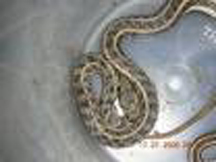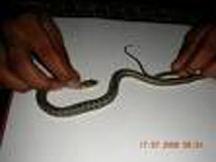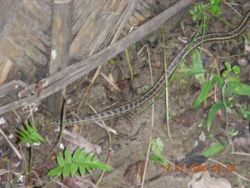FIRST SNAKE!
- Col. Ashwin Baindur
*
My first Monday morning in Binnaguri, Duars, North Bengal. At eight o’çlock after
breakfast, I opened the door to find my sahayak waiting to inform me that Chamkaur
Singh, the Mess Havaldar had caught a snake and brought it to show me.
 Remembering that the last time he brought me ‘ek madi-si saanp’ and poured it on the
floor from a ‘matka’, it had turned out to be a saw-scaled viper, I was hesitant. Chamkaur
appeared, pleased that he had got a second snake for the nature loving CO sahab, and
promptly flipped a plastic bottle thereby forcing me to grab onto a thin beautiful
Remembering that the last time he brought me ‘ek madi-si saanp’ and poured it on the
floor from a ‘matka’, it had turned out to be a saw-scaled viper, I was hesitant. Chamkaur
appeared, pleased that he had got a second snake for the nature loving CO sahab, and
promptly flipped a plastic bottle thereby forcing me to grab onto a thin beautiful
sinuously sliding beauty. Juggling it from hand to hand till I got a grip behind its neck, I went and fetched my snake books. I use the dependable
Book of Indian Reptiles and Amphibians by J.C. Daniels and the ubiquitous
Common Indian Snakes - A Field Guide by India’s snakeman - Romulus Whitaker. These faithful buddies promptly informed that the snake in my hand was a
Buff-striped Keelback with scientific name
Amphiesma stolata (Linnaeus),
that it was gentle, ate frogs and was totally harmless.
The Buff-striped keelback had been feeding on a struggling frog when the Mess Havaldar gleefully pounced on him/her and before he knew it he was deprived of a meal,
entrapped in a pearl-pet bottle and being stared at by an incredulous mess-waiter who promptly claimed it to be a cobra! Naturally the CO sahab had to handle the snake and force a number of reluctant people to touch what they considered to be the most poisonous
snake they had seen in their lives while their compatriots thoroughly enjoyed their discomfort. This the Mess Staff considered as justified payment for fulfilling one of CO sahib’s ‘khwahish’.
The Buff-striped Keelback is a gentle and beautiful snake, which is found across India upto 2000 feet and is usually found along river banks, marshy areas and wetlands.
Binnaguri in the monsoon with its heavy rainfall, lush vegetation and many standing pools is typical buffstriped keelback country. The keelback is usually olivaceous
brown but our snake was grayish. The keelback has irregular crossbars on the body; our snake had prominent crossbars with beautiful golden spots on each side of bar. The two buff-coloured stripes along the sides are the distinctive feature of this snake. The
head has beautiful yellow on its sides and tapers to form a distinctive neck. There were black vertical markings in front and behind the large eyes with round pupils. The body has a long slender tail, which is almost a quarter of its length.
Our snake, true to its reputation, twisted and struggled but never attempted to bite. I took great care to hold the struggling snake without squeezing it too hard. We
then placed it on a paper and measured the struggling snake and found which was around 52 cms long. Normally striped keelbacks grow to 62 cms or so and the record is 90 cms. Next I asked
Chamkaur Singh to take a snap but soon realized that he was not capable of doing it. I called some officers to help me. Capt Abhishek held the snake and also photo-graphed me holding it. 
Later Capt Meghna came and gingerly handled the snake despite her fear of snakes from childhood. The snake was returned to its bottle for safe transport to the wild.
Alarmed, it inflated its body so that it was jammed against the sides of the bottle. This inflation gave delicious thrills to the peering Mess staff even more. In some cases the head even widens to provide a narrow hood. At such times, this totally harmless
and non-poisonous snake is mistaken by unknowing people to be a baby cobra and killed.
 Realising that it was high time we set it free, I stirred the snake with a twig and
inverted the bottle onto the ground. It formed a beautiful sight but before I could
photograph it, the keelback sinuously reached the end of the garden. A quick snap-shot managed to catch it just before it disappeared back in the wild. It was truly a wonderful first record for me from Binnaguri!
Realising that it was high time we set it free, I stirred the snake with a twig and
inverted the bottle onto the ground. It formed a beautiful sight but before I could
photograph it, the keelback sinuously reached the end of the garden. A quick snap-shot managed to catch it just before it disappeared back in the wild. It was truly a wonderful first record for me from Binnaguri!
( Text and photos Lt. Col. Ashwin Baindur,
Col at Indian Army commanding an Engineer Regiment
at Indian Army)